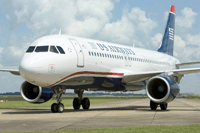It is not often that an airline executive likens his carrier's competitive position to a "our hand of cards", but that is exactly the term US Airways president Scott Kirby uses as he explains the airline's less favourable position among its US network peers.
Kirby and carrier chief Doug Parker believe in the resiliency of their carrier despite the multiple pre-obituaries issued for US Airways in the past few years.
"People are constantly counting us out," said Kirby recently in Phoenix. "And yet we manage to survive." He displays a quote from Caylon Securities issued in 2009 that warned of problems in early 2010 for some carriers, particularly US Airways, if efforts to raise cash failed to materialise. It turns out US Airways in 2009 concluded deals to generate roughly $450 million in liquidity improvements in 2010.
 |
|---|
US Airways has improved its cash balance by $150 million from the beginning of 2011 and its cash cushion is roughly $2.45 billion. Chief financial officer Derek Kerr says while he recognises US Airways' cash on hand is less than other network carriers, he stresses those airlines have recently bolstered their cash balances to pay down debt, a strategy that Kerr says is unnecessary for US Airways during the next couple of years.
Yet despite continually proving that it can bring itself back from the brink, the hand of cards dealt to US Airways remains unchanged, particularly smaller hubs in Philadelphia, Phoenix and Charlotte that generate less revenue and international traffic than powerhouses of Chicago, Atlanta or Newark. Phoenix is dominated by Southwest and an unequal portion of lower-yielding leisure passengers relative to other legacy hubs.
The result of operating from seemingly weaker hubs is a 15% stage-length adjusted passenger unit revenue shortfall compared with US Airways legacy competitors, but conversely a 16% unit cost advantage excluding fuel and special items compared with US titans United-Continental, Delta and American.
Compared with US low-cost carriers, US Airways says it enjoys a 21% unit revenue advantage but a 23% unit cost disadvantage.
So where does this leave US Airways after the cards are shown? "We have a different model than anyone else and that model works," declares Parker. "We know who we are and we know who we're not."
Who US Airways is at the moment is a carrier that improved its pre-tax margin by 8.5 points in 2010, and even though its 3.5% pre-tax, ex-special item margin fell below Delta, United, Alaska, JetBlue and Southwest, Parker believes its proof the carrier's standalone business works.
But he admits posting a positive performance in a single year does not translate into successful longevity, and US Airways more than anyone needs to control its destiny through a sustained profitability that outrivals its peers.
US Airways management candidly tells employees its 16% cost advantage relative to other network carriers largely rests on lower labour expenses and in no uncertain terms stresses that it cannot agree to wages earned by staff at those airlines.
"It means we cannot close contracts that pay the same as American, United and Delta," says Parker. "That's what the old US Airways did. We have to do more with less." He concludes there is "room for nice pay increases", but not raises that take US Airways' cost structure where expenses of other legacies reside.
By reining in costs and creating new revenue streams through baggage fees, choice seats and a la carte food sales that generated $514 million in revenue last year, Parker believes US Airways is creating the framework to control its own destiny.
Even as US Airways feels confident about its footing, determining the fortunes of any other airline at the moment remains murky as oil prices continue their steady climb. US Airways ceased hedging in 2008 after wildly fluctuating fuel prices left some carriers under water with their hedging schemes.
It paid roughly 59¢/litre ($2.24/USgal) for fuel last year, which it says was lower than prices paid by the major US network and low-cost carriers.
However, US Airways estimates that its fuel bill for 2011 has already doubled from projections of $700 million last December to $1.4 billion. It remains to be seen how many fare hikes corporate and leisure carriers can bear, but analysts at JP Morgan believe that even as US Airways remains highly exposed to rising fuel costs by not hedging, "the company can produce a 2011 earnings outcome in the low $1 range unless fuel prices move materially higher from here".
Few discussions with Parker and US Airways management end without discourse about further consolidation. Despite being shunned last year after Continental swooped to woo United, US Airways welcomes the consolidation, and considers it one of the tenets, along with capacity cuts and product unbundling, that is easing anxiety over the run up in fuel prices.
Among the four major US carriers Parker surmises there is "one big deal that's left", and that transaction could involve US Airways. "It could happen one day," says Parker. "It may not."
Read more on the improved profitability of US network carriers
Source: Airline Business



















